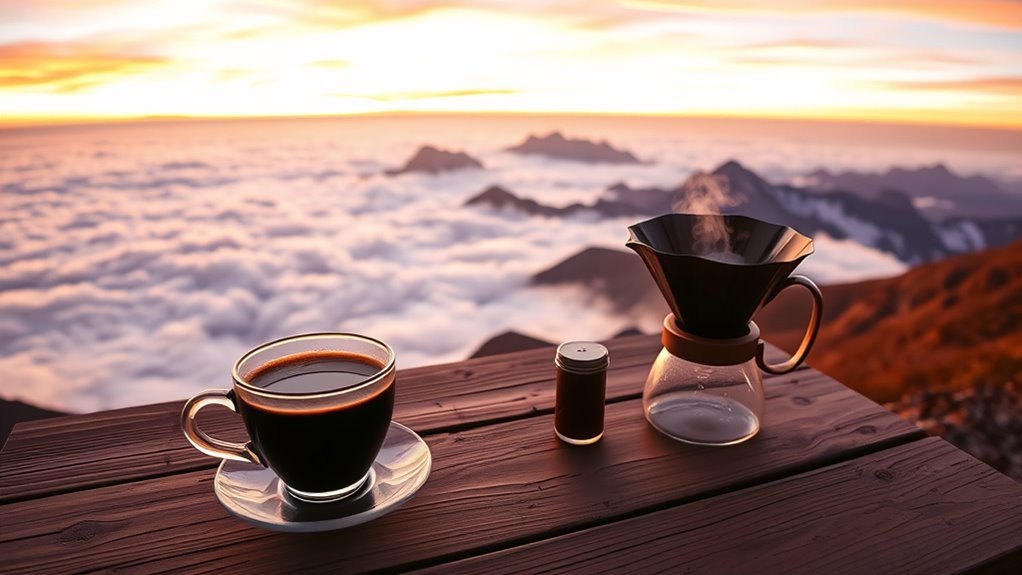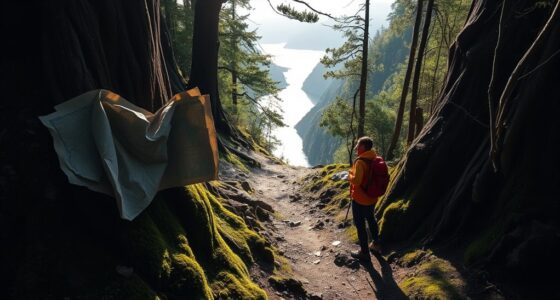Brewing coffee at 10,000 feet on an Andean ridge means you’ll notice brighter, more intense aromas and a lighter, more vibrant flavor profile due to the lower boiling point and thinner air. You’ll need to adjust grind size and brewing time to manage faster extraction and acidity. Environmentally, sharp scents and crisp mountain air heighten your sensory experience. Stay with us to discover how these altitude effects can elevate your coffee craft even further.
Key Takeaways
- At 10,000 feet, water boils at a lower temperature, requiring adjustments in brewing time and technique for optimal flavor.
- The thinner atmosphere enhances aromatic intensity, making coffee scents sharper and more vibrant during brewing.
- Higher altitude results in lighter-bodied coffee with increased acidity and complex flavor nuances.
- Brewing methods like pour-over or French press need fine-tuning in grind size and exposure time to adapt to environmental changes.
- The breathtaking mountain setting heightens sensory perception, elevating both aroma and taste experiences in high-altitude coffee brewing.

If you’ve ever wondered how your morning coffee tastes when sipped at 10,000 feet, you’re in for an adventure. The high altitude dramatically influences the brewing process and, more intriguingly, the flavor profiles of your favorite brew. At such elevations, the thinner air and reduced atmospheric pressure affect how water interacts with coffee grounds, leading to noticeable differences in taste. The altitude effects mean water boils at a lower temperature—often around 90 to 95°C (194-203°F)—which can alter extraction times and flavor development. This lower boiling point causes the coffee to brew more gently, often resulting in a cup that emphasizes brightness and clarity over the rich, heavier notes you might find at sea level. Additionally, the unique environmental factors at high altitude can impact the coffee’s aroma development during brewing, making the scent sharper and more intense. Your typical brewing methods will need some adjustment to account for these altitude effects. For instance, if you’re using a French press or pour-over, you might find that your coffee extracts faster or that you need to tweak grind size and brewing time. Because water boils sooner, you may notice that your coffee’s body is slightly lighter, and the acidity becomes more pronounced. This heightened acidity at high elevations brings out vibrant citrus, floral, or fruity notes that might get overshadowed at lower altitudes. As a result, the flavor profiles become more complex, allowing you to experience nuances that are often muted elsewhere. Furthermore, the environment at 10,000 feet influences how the coffee’s aroma develops during brewing. The reduced humidity and thinner atmosphere can make the scent sharper and more intense. You might find yourself inhaling more of the coffee’s aromatic compounds, enhancing your overall tasting experience. The crisp mountain air also elevates your senses, making each sip feel more alive and invigorating. Brewing at high altitude isn’t just about adjusting techniques; it’s about embracing the differences. You learn to appreciate how environmental factors shape your cup, turning every brew into a mini-science experiment. This elevated environment highlights the delicate balance between extraction and flavor, encouraging you to explore new grind sizes, brewing times, and beans. Understanding how biodiversity hotspots impact local ecosystems can deepen your appreciation for the unique environment you are brewing in. Whether you prefer a bright Ethiopian Yirgacheffe or a balanced Colombian, you’ll find that altitude effects transform the way flavors emerge and evolve. In the end, drinking coffee at 10,000 feet isn’t just about caffeine—it’s about experiencing coffee’s full potential in one of the most breathtaking settings on Earth.
Frequently Asked Questions
How Does Altitude Affect Coffee Bean Flavor Profiles?
Altitude profoundly impacts coffee flavor, and you’ll notice this through the distinct bean characteristics it develops. Higher altitudes tend to produce beans with brighter, more complex flavors due to slower maturation. As you enjoy coffee from these regions, you’re tasting the unique altitude flavor, which enhances brightness and acidity. So, by growing coffee at high elevations, you’re experiencing beans that offer a richer, more vibrant profile.
What Special Equipment Is Needed to Brew at High Elevations?
At high elevations, you’ll want altitude-specific brewing gear to guarantee great taste. You’ll need equipment calibration to account for lower boiling points and thinner air, ensuring proper extraction. A precision grinder, a reliable kettle, and a calibrated coffee maker are essential. By adjusting brewing parameters and using the right equipment, you’ll access the full flavor potential of your beans, making every cup a high-altitude masterpiece.
Are There Health Benefits to Drinking High-Altitude Coffee?
You might wonder if drinking high-altitude coffee offers health benefits. While it won’t cure altitude sickness, it can boost your hydration strategies and keep you alert in thin air. The caffeine provides a quick energy boost, but remember, dehydration is common at high elevations, so drink plenty of water alongside your coffee. Overall, moderate consumption can enhance your experience, but don’t rely on it to manage altitude sickness.
How Does Weather Variability Impact Coffee Cultivation at 10,000 Feet?
Imagine weather variability at 10,000 feet as a wild rollercoaster, shaking up your coffee crops! Microclimate shifts and seasonal rainfall variability can dramatically affect growth, causing unpredictable harvests. You might see sudden frosts or droughts that threaten your beans. These extreme changes challenge cultivation, forcing you to adapt constantly. High-altitude coffee farming becomes a battle against nature’s mood swings, making every harvest an unpredictable adventure.
Can High-Altitude Coffee Production Be Scaled Commercially?
You can scale high-altitude coffee production commercially by focusing on altitude farming and enhancing crop resilience. High elevations challenge growers but also offer unique flavor profiles that command premium prices. With proper techniques like selecting resilient coffee varieties and implementing sustainable practices, you can overcome climate variability and boost yields. Investing in infrastructure and training further supports sustainable growth, making high-altitude coffee farming a viable, profitable venture.
Conclusion
As you sip this high-altitude brew, remember you’re tasting more than coffee—you’re capturing the spirit of resilience and elevation. Each cup symbolizes reaching new heights, defying limits, and embracing the boldness of the Andes. Just as the mountain stands tall and unwavering, your journey with this coffee reminds you that greatness often begins at the summit. Let this rich, spirited brew inspire you to climb higher, dream bigger, and savor every moment of your own ascent.











